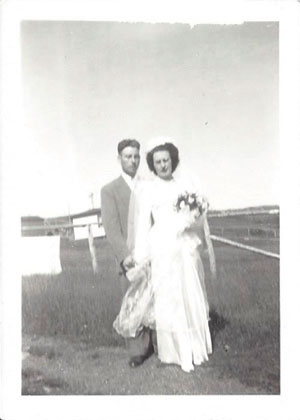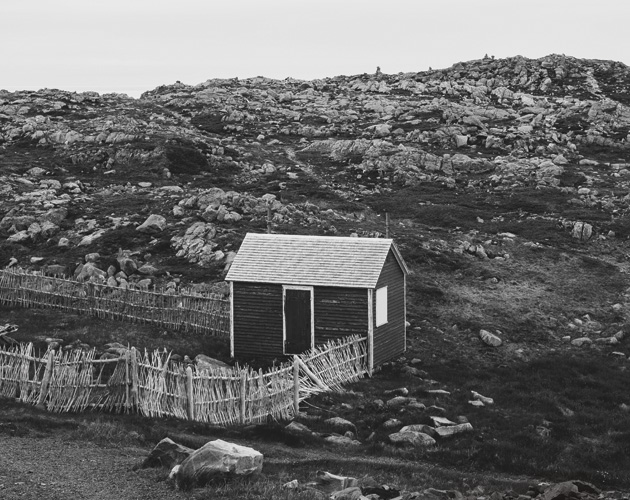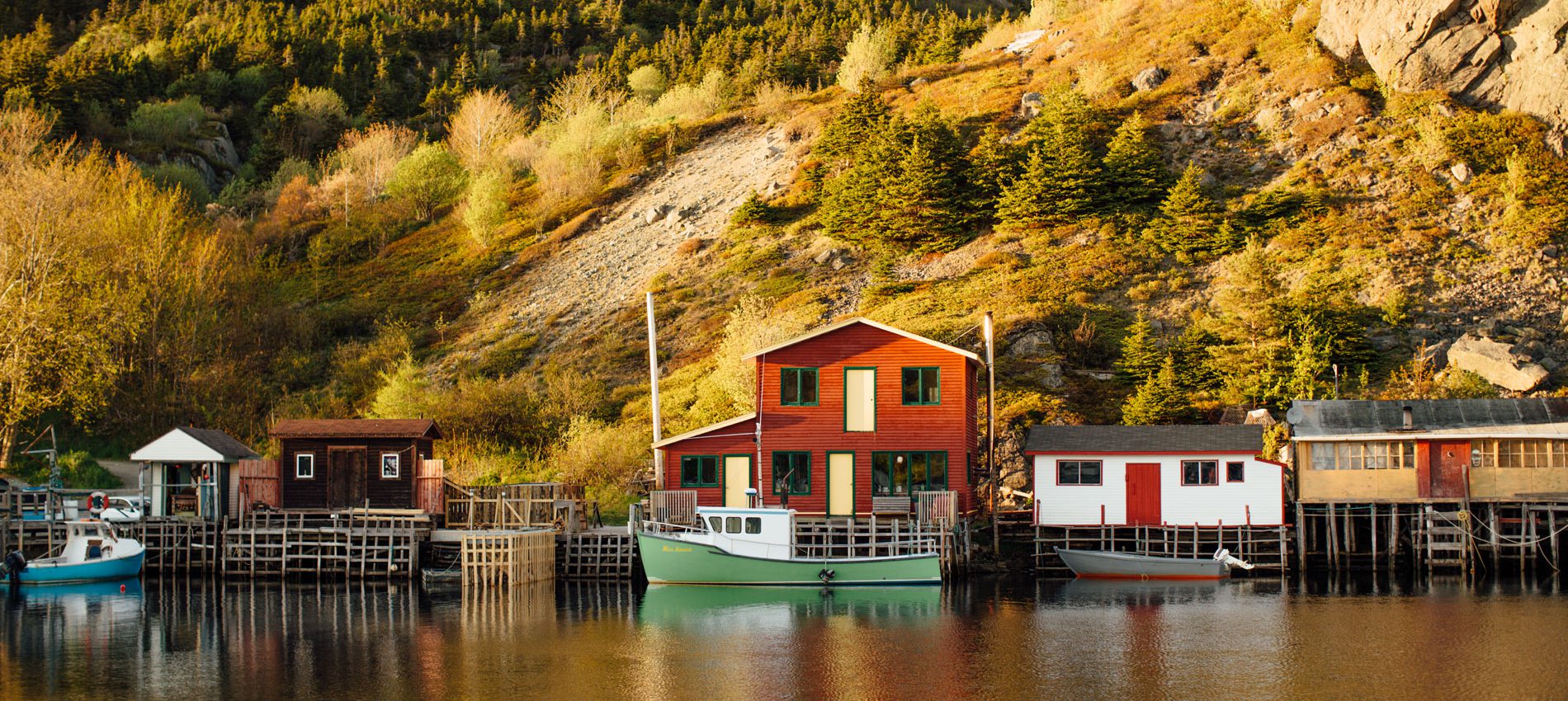For Arlene Stacey, a sentimental journey to Newfoundland, the province of her birth, deepens the family ties that bind.
When the place of birth on your passport says Come By Chance, you get through customs pretty quickly – “C’mon, Come By Chance?” My response: “Yes, my parents met in Heart’s Delight, married in Heart’s Content, honeymooned in Conception Bay, and I was born in Come By Chance.” Of course, only the last part is true, and I have an older sister but, as any Newfoundlander can tell you, there’s no reason to let truth stand in the way of a good story.
And Newfoundlanders are nothing if not good storytellers: Michael Crummey, Cathy Jones, Shaun Majumder, Rick Mercer, Donna Morrissey, Gordon Pinsent, Mary Walsh and Alan Doyle.

My parents’ stories of mummers (neighbours dressed in disguise who drop by to entertain with a song or a dance in exchange for rum or whisky “grog”) and kitchen parties, isolation yet sense of community and generosity growing up in the Dominion of Newfoundland are uniquely of the Rock – the province remains the most unstinting in Canada, with 92 per cent of the population giving to charitable causes. And remember the openhandedness of the people of Gander in response to the diversion of airplanes and the arrival of thousands of come-from-aways in the aftermath of the 9-11 attacks, an episode in the Tony Award-winning musical Come From Away). While I know most of my mother’s family in the town of Port Blandford about an hour’s drive from Gander, my purpose is to discover the outport where my father was born.
Map in hand and with simple directions from the woman at Tourist Assist outside St. John’s International Airport – “Easy, m’dear. If you’s leaving the city on the TCH [Trans-Canada Highway], you’s goin’ west. To come back, go east.” I’m heading east (though it seems to be north to me) to the turnoff at the delightfully named town of Goobies. At the Irving station here, the 12-foot-high moose isn’t talking, but I clearly remember my delight as an eight-year-old beneath the gigantic statue as he bellowed out some long-forgotten message to my sister and me when my uncle stopped for gas. Few old-timers are around to ask, and the young folk don’t remember it talking – but I do. I also remember the signs on the Trans-Canada Highway, which stretches almost 1,000 kilometres from the eastern capital of St. John’s to Port aux Basques in the southwestern tip of the island, praising “We’ll finish the drive in ’65, thanks to Mr. Pearson.”
From the turnoff at Goobies, a 15-minute drive takes me to the community of Swift Current, where my eight-year-old father, four of his nine siblings and my grandmother Sarah spent the winter of 1936 after my grandfather Josiah Stacey died from a ruptured appendix. While many of the mailboxes bear the name Stacey, none of them are related to me – that I know of.
Roger Jamieson, owner of the Kilmory Resort, my home for the night, knows most of the people in town, and he agrees – but won’t swear to it. His picturesque chalet development overlooks Piper’s Hole River, built on land owned by his father Don. He was the first Newfoundlander to sit in the press gallery in Ottawa’s House of Commons in 1945 to report on negotiations that led to Canada inviting Newfoundland to join Confederation in 1949 – or vice versa as more than one Newfoundlander asserts. Don was vehemently opposed, yet he later became a respected Liberal MP – while Joey Smallwood was the new province’s first premier. In Newfoundland, there really is only six degrees of separation – or less: Don and my grandmother Sarah were raised in the same home on nearby Sound Island after she was orphaned.
“Jeffrey’s Cove is just over there,” shouts skipper Loyola Pom-roy over the sound of the Merasheen‘s engine, pointing to a tiny inlet on the mountainous rugged six-mile-long Sound Island where my paternal grandparents raised 10 children in a two-storey, four-bedroom house without electricity or running water. Sound Island was one of about 50 outports deserted before the forced government-assisted resettlement programs went into effect from 1954 to 1975, which relocated small communities because of lack of work, medical care, schools and churches. Houses were towed across turbulent waters to nearby settlements – all by manpower alone without the use of horses or machines. But we can’t moor here and continue on to a smaller island south of Sound (Woody Island, my dad scoffs, was just a suburb of Sound when he was a kid). The Woody Island Resort, run by brothers Gary and Loyola Pomroy, promises a glimpse of a pre-Confederation Newfoundland: no telephone, TV or internet but definitely home-cooked meals, good conversation, laughter and a glimpse of island humour – including mummers. After my visit to the island’s museum where I see a cap for the 1993 Sound Island reunion, I regret not accompanying my father that year to the 50th anniversary of the abandonment of the island when he brought a headstone for his father’s grave almost six decades after his death.

After eating more toutons (bread dough fried in pork fat or butter) drizzled with molasses than I can believe possible (some of them come close to being as good as my maternal grandmother’s although I don’t remember her calling them toutons), dancing with mummers who join us after dinner (some of them may have been women although in my parents’ stories they were always men) and falling asleep with the winds roaring outside my window, we head back to the mainland, washing down buttery tea biscuits with hot tea during the trip.
At Terra Nova Resort in Port Blandford, my cousin Barb Greening pulls up in her treasured red Corvette, a birthday surprise from her husband, Joe, to show me what’s new in the town of 500 since my last visit almost a decade ago. We pass homes with shiny new trucks and four-wheelers in the yard – “You can tell who’s spending all the money they’ve earned in Fort McMurray,” laughs Barb (before that city’s devastating fire, almost 15 per cent of its population was from this province).
This is the part of Newfoundland I am more familiar with: my maternal grandmother’s house, built by my grandfather, Alex Oldford, had stood just a few miles down the road, overlooking Clode Sound in Bonavista Bay. My mother’s younger brother, Roy, and his wife, Enid, now live in a house they built on that same parcel of land. And one of their daughters and her family have moved back in recent years. Dinner at Barb’s includes almost everyone I’m related to in Port Blandford. The last time I had seen them all was 20 years ago when my now husband, Jim, was “screeched in” as an honorary Newfoundler, with the customary kissing of the cod.
Instead of Heart’s Delight, my parents really met in Sunnyside in 1947 where my mom was teaching and boarding with my dad’s oldest brother’s family. Dad planned to head to the “mainland” after the Dominion of Newfoundland joined Confederation in 1949. But before he left, he proposed, promising he would return to marry her in 1950 after finding a job and a home for them in Toronto. They married in Port Blandford, not Heart’s Content. And instead of honeymooning in Conception Bay, they celebrated by travelling to Toronto – accompanied by one of their attendants, Gertrude Guppy. But I truly was born in Come By Chance, when my mother – pregnant with me – returned home to visit family with my then three-year-old sister.
Between uncovering my dad’s roots and reconnecting with my mom’s, I rediscovered my connection to the Rock. But you don’t have to have relatives to enjoy the welcoming friendliness of Newfoundlanders: as Arthur Black once said in the pages of this magazine: “That’s Newfoundland. Small-ish, as islands go, but with a heart as wide as the Prairies.”
If you go
Globus Tours has escorted tours across the island.
www.globusjourneys.ca
Kilmory Resort, Swift Current
www.kilmoryresort.com
Woody Island Resort, Woody Island
www.woodyi.com
Terra Nova Resort & Golf Community
www.terranovagolf.com
A version of this article appeared in the October 2017 issue with the headline, “No Place Like Home,” p. 76-78.
